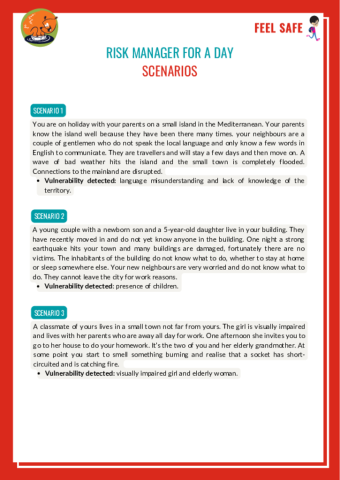Risk Manager for a day
Objectives:
- Get to know the meaning of vulnerability in risk contexts
- Stimulate problem solving
- Increase individual and community capacity
STEP BY STEP
BEFORE STARTING
The teacher begins the activity with a brainstorming session centered around the word "vulnerable." The teacher asks each student to write down their understanding of the term and to provide examples if possible. After everyone has shared their definitions, the teacher will present the official definition from the glossary:
Vulnerability - The propensity to suffer damage from an event.
WHAT DOES VULNERABILITY MEAN?
The teacher explains that vulnerability Propensity to suffer damages from an event is a risk The possibility that a phenomenon may cause harm to people, settlements and the environment in a given period of time and in a given area factor, but what does this mean in practical terms?
Vulnerability refers to the degree of potential loss that can occur due to a specific phenomenon. This is measured on a scale from zero to one, where zero indicates no damage and one represents total destruction.
The teacher emphasizes that vulnerability can be reduced through a community's ability to prepare for disasters and effectively manage emergencies.
IMAGINE A CALAMITOUS EVENT
The teacher guides the class in imagining an earthquake Sudden ground shaking resulting from movements of the earth’s crust occurring at their school. The discussion starts with the vulnerability Propensity to suffer damages from an event of the school building. The teacher poses questions such as:
- How do students think the school structure would respond to an earthquake?
- Where would they feel safest, and where would they feel most at risk The possibility that a phenomenon may cause harm to people, settlements and the environment in a given period of time and in a given area ?
Next, the teacher shifts the focus to individual vulnerability by asking:
- Who do students think is most vulnerable in this scenario? Would they feel vulnerable? Why?
- Do they believe everyone has access to evacuation information? Do they understand it?
- Are there any obstacles on the route to the assembly point?
- Are there students with physical disabilities or other reasons that might prevent them from following the route?
After addressing these questions, the teacher divides the class into 3 groups and assigns one scenario each (see attached "Risk Manager for a day - Scenarios" below):
Each group is tasked with:
- Exploring their assigned scenario.
- Identifying additional potential vulnerabilities.
- Discussing needs during the emergency.
- Brainstorming intervention strategies.
Each group immerses themselves in their scenario, analyzing possible risks and vulnerabilities. The teacher designates a spokesperson for each group to present their findings to the class.
CONCLUDING THOUGHTS
At the end of the activity, the teacher facilitates a discussion on strategies for effectively addressing the vulnerabilities identified in each scenario. The class ranks these strategies based on their perceived effectiveness, providing reasons for their choices. The teacher guides this discussion by writing the strategies on the board, helping to structure the ranking process.

Add new comment